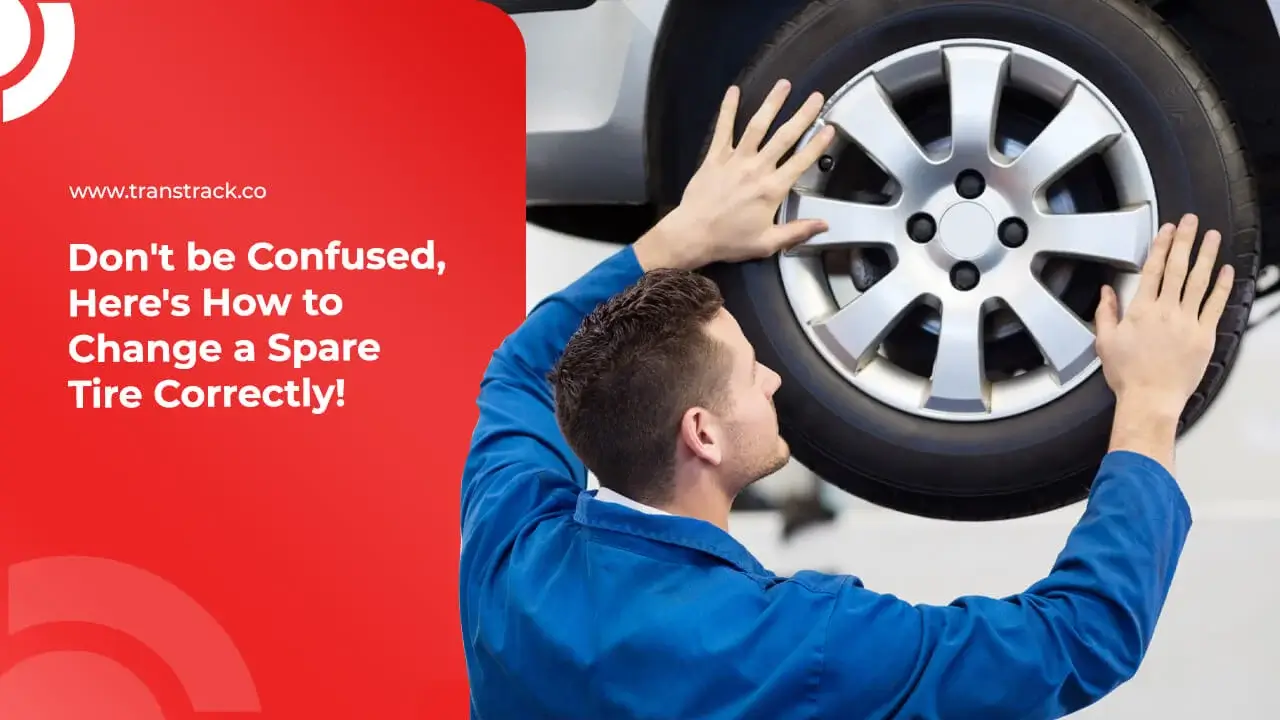Don’t be Confused, Here’s How to Change a Spare Tire Correctly!
Posted on April 23, 2024 by Nur Wachda Mihmidati

How to change a spare tire must be learned from the start. Because when driving, nothing is more annoying than finding a flat tire in the middle of a trip. However, when a situation like this occurs, having the knowledge and skills to change a spare tire quickly and efficiently can be a lifesaver. In this article TransTRACK, we will discuss the steps that need to be taken to change the spare tire smoothly and without difficulty. From knowing the position of the spare tire to using the right tools, let’s explore the proper process to ensure safety and convenience when facing an emergency on the road. Get ready to learn how to solve a flat tire problem confidently and independently!
How to Change a Spare Tire
The following steps are good enough to change the spare tire. These are the common steps:
Knowing the position of the spare tire
The position of the spare tire may vary depending on the type of vehicle. Usually, the spare tire is stored in the trunk for sedan cars or in the back of SUVs or trucks. Some vehicles may have a dedicated storage area outside the vehicle, such as at the bottom of a truck or under a car.
Prepare the necessary tools
Necessary tools include a jack, a wheel wrench that matches the size of your vehicle’s tire bolts, and if necessary, a tire bolt polisher or cross wrench to make it easier to unscrew tire bolts that may be tight or rusted.
Loosening tire bolts
Loosening the tire bolts before lifting the car with a jack is essential to avoid difficulties when removing the tires. Slightly loosening the bolts is sufficient, as they still need to be secure to support the weight of the vehicle when lifted.
Installing the jack in the correct position
The correct position to place the jack is usually indicated in the vehicle manual. Generally, there are lifting points located under the vehicle chassis that are strong and stable.
Remove all tire bolts
Be sure to remove all tire bolts before lifting the car with a jack. This includes unscrewing all bolts in the pattern recommended by the vehicle manufacturer.
Install the spare tire
When installing the spare tire, be sure to install it correctly so that it is aligned with the other wheels. If the spare tire is a temporary tire (for example, a doughnut tire), pay attention to the instructions on the tire about speed limits and safe mileage.
Tighten the tire bolts
When tightening the tire bolts, be sure to do so carefully and consistently. Use a wheel wrench to tighten the bolts in a star pattern so that the wheel fits evenly and stably.
Removing the jack
When all the tire bolts are securely in place, slowly lower the car with the jack until the wheels touch the road surface. Make sure the spare tire is securely attached to the wheel hub before fully releasing the jack.
Besides the main steps mentioned earlier, there are some additional steps that are important to consider:
Safety first
Make sure to park the vehicle in a safe and flat place before starting the tire changing process. Activate the handbrake to ensure the vehicle remains stationary during the tire change. Also, if possible, put up warning signs or hazard lights to let other drivers know that you are making repairs.
Check the condition of the tire
Before installing the spare tire, you should check the condition of the tire. Make sure there is no damage or leaks that could affect the performance of the spare tire. If the spare tire is a donut tire or spare tire, be sure to check the recommended speed and mileage limits.
Pay attention to vehicle manual instructions
Each vehicle may have specific instructions in its manual on how to change a tire. Always check your vehicle manual for manufacturer’s recommendations and instructions.
Pay attention to tire bolt adjustment
Some vehicles may be equipped with special tire bolts or locking systems that require special adjustment. Be sure to follow the manufacturer’s instructions when removing and installing tire bolts.
Check air pressure
Once the spare tire is installed, check the air pressure inside. Make sure the spare tire air pressure is in accordance with the vehicle manufacturer’s recommendations. Improper air pressure can affect vehicle performance and driving safety.
Recheck tire bolts
After a few kilometers of travel, check the tightness of the tire bolts again. Vibration and movement while driving can cause the tire bolts to loosen. Be sure to double-check and tighten the tire bolts if necessary.
Recheck the replaced tire
Once the damaged tire has been replaced, recheck the tire at a tire shop or service station to determine the cause of the damage. This can help in detecting further problems in the vehicle that need to be repaired.
Once all steps are complete, be sure to put the old tire, tools, and equipment back in their original place. Also check the air pressure in the spare tire and make sure it is within the vehicle manufacturer’s recommendations before continuing the journey. If there is any doubt or uncertainty, it is better to ask for help from a professional mechanic or someone who has experience in changing tires.
By using TransTRACK’s Vehicle Maintenance System, changing the spare tire is not only a routine task, but also an opportunity to improve driving efficiency and safety. With this tool, you can:
- Save Time: TransTRACK allows you to plan and schedule spare tire replacement efficiently, so you don’t have to spend excessive time during emergencies.
- Improves Reliability: With tire usage tracking and regular maintenance, you can improve the reliability of your vehicle. By knowing when to replace tires, you can avoid unexpected events on the road.
- Improves Safety: Worn tires can lead to accident risks. By using TransTRACK to monitor tire conditions and make timely replacements, you can improve the safety of yourself and other road users.
- Reduce Maintenance Costs: By replacing your spare tire in a timely manner, you can reduce the risk of further damage to your vehicle and save on unnecessary repair costs.
- Improved Operational Efficiency: With better maintenance management through TransTRACK, you can improve the operational efficiency of your vehicle fleet, be it for business or personal use.
With the features and benefits offered by TransTRACK’s Vehicle Maintenance System, you can manage vehicle maintenance more effectively and efficiently, so you can focus on other important things in your daily life. Start using TransTRACK today and make your spare tire changing experience easier and more efficient than ever!
Recent Post
Topic :
 Bahasa Indonesia
Bahasa Indonesia









